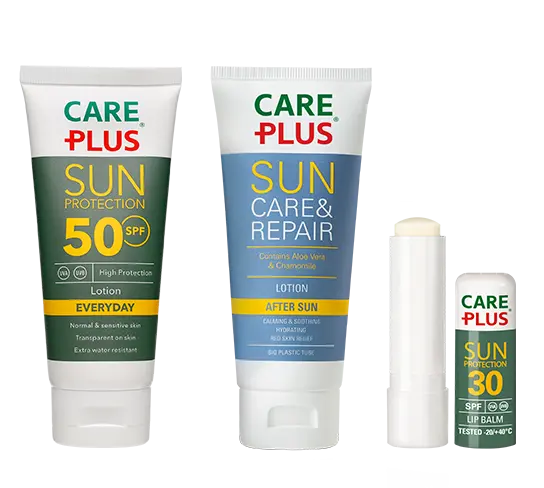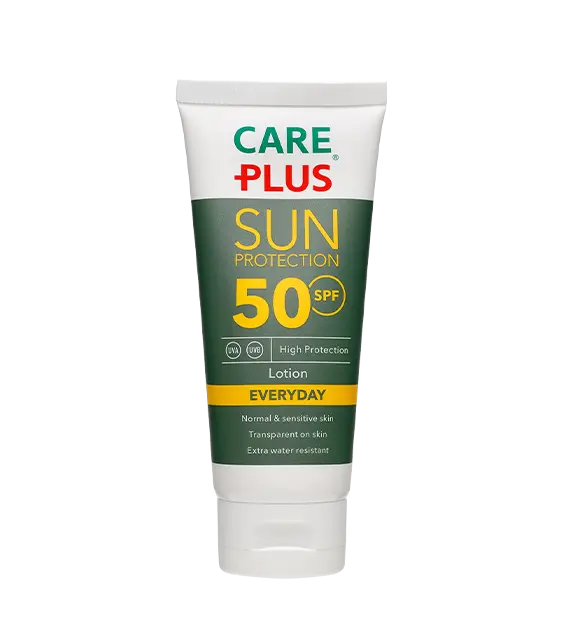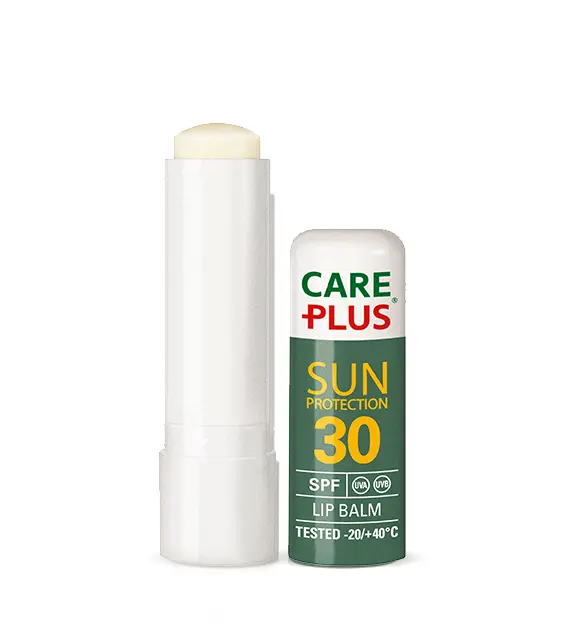Planning on being active outdoors? Then opt for the highest protection!
Whenever we can, we like to be outside. Go for a walk, exercise and of course enjoy the sunshine and warmth. But the sun can also be dangerous. Because what we cannot see with the naked eye is UV (Ultraviolet) radiation. Radiation come in two types: UVA can damage and age your skin. Furthermore, too much UVA can even cause skin cancer. UVB ensures that our bodies produce much-needed vitamin D. But it can also burn your skin. Care Plus® has the right products to protect your skin when you are enjoying your outdoor activities. And to take care of your skin after an active day in the sun.

Protect yourself in every season
Sunscreen is especially important in summer, of course. But you can also get sunburned in winter and while skiing. This has to do with solar radiation and reflection.
Sun radiation
The shorter the distance UV rays have to travel, the stronger they are. When the sun is directly overhead, this distance is shortest. In summer, this is between 12:00 and 15:00. Higher in the mountains, the sun is also more powerful because the UV rays reach you sooner.
Clouds and reflection
Clouds block radiation. But thin clouds, like those we see in hazy weather, do not. Good to know: UV radiation is 10-20% stronger when it reflects off sand or water. With fresh snow or ice, this is even 80-90% stronger! So protect yourself well in winter, too.
Skin types and sun protection factors
Every sunscreen has a factor: the Sun Protection Factor (SPF). There’s a simple rule for choosing your SPF: the lighter your skin and the more direct sunlight, the higher the SPF. If you have tanned skin, you can use a lower SPF. For children, the recommendation is a minimum SPF of 30. Choose SPF 50 if you don’t want to take any risks. Keep babies completely out of the sun. Their skin is still too delicate.
Protection for an active outdoor life
Care Plus® helps you with optimal sun protection. With products tailored to your activities.
Tips for sun protection:
- Apply your sunscreen 30 minutes before sun exposure.
- While you’re in the sun or working, reapply every 2 hours.
- The sun is at its strongest between 12:00 and 15:00.
- We recommend seeking shade during this time.
Apply liberally. Applying too thinly significantly reduces the SPF.
Care Plus® Sun Protection Everyday Lotion
Both for you and for children, there is the Care Plus® Sun Protection Everyday Lotion. Ideal for sunbathing in your garden, on your balcony and taking with you to the beach or on vacation. It is quick and easy to apply. Convenient when you’re quickly going out. Care Plus® Sun Protection lotion is suitable for normal and sensitive skin and available in SPF 30+ and SPF 50+. Care Plus® does a lot of research into the best protection for your skin. The result is a unique formula that also offers protection against jellyfish stings.
Care Plus® Care & Repair After Sun
Take good care of your skin after exposure to the Sun and especially if the skin is burned. Care Plus® Care & Repair After Sun contains natural ingredients that nourish, soften and help restore your skin.
Care Plus® Sun SPF 30 Lip Balm
The SPF 30 Lip Balm cares for and protects your vulnerable lips extremely well. From -20 to +40 degrees Celsius.
Frequently asked questions about sunscreen and sun protection
How do I apply sunscreen?
Tips:
- Apply your sunscreen lotion or gel 30 minutes before your anticipated sun exposure.
- As long as you are exposed to the sun; reapply every 2 hours.
- The Sun is strongest between 12:00 and 15:00. We advise you to find shade.
- Apply generously. Applying too thinly reduces the protection factor considerably.
How do I use sunscreen and insect repellent together?
Sunscreen with chemical filters is recommended to be applied 20 to 30 minutes before sun exposure, allowing it to penetrate thoroughly for optimal protection. You’ll want to apply the insect repellent on top of this. Therefore, we recommend applying the insect repellent 20 to 30 minutes after applying the sunscreen. Note: never apply this directly in the sun or on sunburned skin. Do not use in direct sunlight.
With a full mineral sunscreen, you can go straight into the sun. This sunscreen forms a layer on top of the skin that reflects the sun and will not penetrate the skin. The insect repellent can then be applied immediately after application.
However, the use of sunscreen and insect repellent is only necessary in high-risk areas where mosquitoes are active during the day. This is the Aedes mosquito, also known as the tiger mosquito, which can transmit diseases such as yellow fever, chigunguya, dengue, and Zika. It’s also recommended in areas where ticks are active (usually not on beaches, but in dune areas).
We recommend wearing clothing that covers your skin as much as possible, as this also provides better sun protection, and applying insect repellent only to exposed skin.
Anti-Insect is not waterproof and must be reapplied after swimming and sweating. It’s advisable to wash off all products and reapply them first.
What should I do if sunscreen gets in my eye?
If sunburn gets in your eye, rinse immediately with lukewarm water. Avoid rubbing and wearing contact lenses or using eye drops unless directed by a doctor. If irritation persists, consult a doctor or ophthalmologist.
What to do if I swallowed sunscreen?
If sunscreen is accidentally swallowed, it’s important to first determine whether the person is a child or an adult and whether there are any symptoms. If sunscreen is swallowed, it’s important to avoid inducing vomiting, rinsing the mouth, and giving them something fatty to eat. If symptoms such as coughing occur, or if the person is a child, it’s advisable to consult a doctor.




